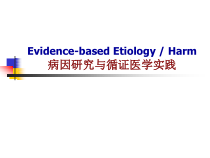 PPT
PPT
【文档说明】循证医学-病因学研究和循证医学实践-新-研课件.ppt,共(63)页,1.195 MB,由小橙橙上传
转载请保留链接:https://www.ichengzhen.cn/view-254963.html
以下为本文档部分文字说明:
Evidence-basedEtiology/Harm病因研究与循证医学实践学习目标◼掌握评价病因性研究真实性原则(Validity)◼掌握评价病因性研究重要性原则(Importance)◼学会应用病因性研究证据的结果,解决临床问题(Applying)病因性研究
基本知识◼病因性研究基本概念◼与病因相关的临床问题◼病因性研究的主要方法◼病因/不良反应研究证据的分级◼病因性研究常用统计学指标病因性研究基本概念(1)◼病因是指引起人体发生疾病的原因。病因学是指研究疾病病因的科学。◼病因
:致病因素(直接、间接、危险因素)◼研究内容:用流行病学方法研究并验证危险因素是否与疾病发生有因果关系,且评估因果联系的强弱。例“吸烟与肺癌关系”病因性研究基本概念(2)◼不良反应的研究实质上也是病因学研究“因”:造成不良反应的各种因素,如各种治疗措施(
药物,手术)◼医疗过程中临床医师经常需要考虑某种危险因素或治疗措施是否对患者有害。利是否大于弊?◼用他人的研究结果来回答提出的问题真实性重要性实用性与病因相关的临床问题◼该疾病是什么原因造成的?◼该药物或治疗措施会
导致什么不良反应吗?是否需要停药?◼DoesexposuretoaluminumcauseAlzheimer’sdementia?◼Dostatinscausecancer?病因性研究的主要方法病因性研究常用统计学指标◼因果相关性强
度的指标RR(前瞻性)RCT,cohortstudyOR(回顾性)case-controlstudy◼NNH(numberneededtoharm)clinicalimportance暴露多少研究对象可导致1例发病(队列研究)发生1
例不良反应所需治疗的病例数(临床研究)因果相关性强度的指标◼当所研究疾病的发病率较低时,OR近似于RR,故在回顾性研究中可用OR估计RR,其解释与RR同,易于统计分析◼RR或OR愈高,则因果关系强度愈强◼RR或OR有多大才有意义,无一定的标准1.2-1.5:弱联
系1.6-2.9:中等联系>3.0:强联系可信区间ConfidenceInterval◼因果关系的强度外,评价精确度◼按一定的概率去估计总体参数所在的范围◼95%的可信区间◼循证医学-估计总体参数-假设检验:RR有关指标的计算1.Od
dsRatio2.RelativeRisk3.RiskReduction/Increase4.NumberNeededtoTreat/Harm證據的強度TheConfusionMatrix+veEvent-veEventTotalExperimentABA+BControlCDC+
DAlsoknownasthe2x2tableEventRate◼EER=A/(A+B)试验组事件发生率◼CER=C/(C+D)对照组事件发生率+veEvent-veEventTotalExperimentAB
A+BControlCDC+DRRandOR◼RR=EER/CER相对危险度◼OR=AD/BC比值比+veEvent-veEventTotalExperimentABA+BControlCDC+DRelativeRiskReduction◼RRR=(CER-EER)/CER=1
–RR相对危险度减少率+veEvent-veEventTotalExperimentABA+BControlCDC+D(Absolute)RiskReductionARR=CER-EER绝对危险度减少率+veEvent-veE
ventTotalExperimentABA+BControlCDC+DNumberNeededtoTreatNNT=1/ARR得到1例有利结果需要防治的病例数+veEvent-veEventTotalExperimentABA+BControlCDC+D举例:A
ctivatedProteinCforSevereSepsisBleedNobleedTotalAPC30820850Control17823840APC=ActivatedProteinCEfficacyandsafet
yofrecombinanthumanactivatedproteinCforseveresepsis.NEnglJMed.2001Mar8;344(10):699-709EventRatesandOdds◼EER=A/(A+B)=30/85
0=0.035◼CER=C/(C+D)=17/840=0.020◼EEO=A/B=30/820=0.037◼CEO=C/D=17/823=0.021+veEvent-veEventTotalExperimen
tABA+BControlCDC+DBleedNobleedTotalAPC30820850Control17823840◼OR=EEO/CEO=0.037/0.021=1.77◼RR=EER/CER=0.03
5/0.020=1.744◼RRI=(EER–CER)/CER=0.015/0.020=0.744=74%◼ARI=EER–CER=0.035–0.020=0.015NNH=1/ARI=66Risk-
BenefitRatio◼NNT=1/ARR=1/0.06=16(治疗16个获益1个:存活)反映有利结果(越小越好)◼NNH=1/ARI=1/0.015=66(治疗66个损害1个:严重出血)反映不良反应(
越大越好)◼Risk-BenefitRatio=NNT/NNH=16/66=1/4DeadNotdeadTotalAPC210640850Control259581840BleedNobleedTotalAPC30820850C
ontrol17823840怎样解决临床问题?Howtosolveaclinicalproblem?临床病案(ClinicalScenario)◼84岁的男性,近期记忆力明显下降.高血压病,高胆固醇血症。◼右眼
白内障术后2天,出现易激、谵妄和性格改变。◼无感染,贫血及代谢异常的临床证据。◼心理卫生中心会诊:抗精神病药物氟哌啶醇,haloperidol,奋乃静perphenazine,奥氮平,olanzapine临床问题(InitialQuestion)◼老年患者中,用传统性抗精神病
药物(如氟哌啶醇,haloperidol,奋乃静perphenazine,)是否会增加死亡风险性?非典型性抗精神病药物(如奥氮平,olanzapine,)是否对老年人更安全?第一步提出问题(AskClinicalQuestions)◼Initialquestion:◼Framingthe
initialquestion:answerablePatients(population)Intervention/exposureComparisonOutcomePICO转变成可以回答的临床问题Framin
gthequestion◼患者类型(P)elderlypatients◼干预措施(I)haloperidolorperphenazine◼对照措施(C)olanzapine◼临床结局(O)death第二步查询证据(A
cquireEvidence)◼PICO:keywords◼Typeofquestion:harm-BestevidenceLevelsofevidence-Optimalsourceofevidence◼Searchingworthwhile?病因/不良反应研究常用
数据库◼BestEvidence(ACPjournalclub,EBM)◼UptoDate◼MedlinePubMed:clinicalquery-etiologySumsearchOvid循证医学数据库(多库同时检索)ACPjournalclub,CochraneLi
brary(CDSR,CCTR,DARE),Medline,EMBASE◼系统评价资料库(CochraneDatabaseofSystematicReview,CDSR)◼疗效评价文摘库(DatabaseofAbstractsofReviewsofEffectivenes
s,DARE)◼临床对照试验注册资料库(CochraneControlledTrialsRegister,CCTR)◼方法学数据库(CochraneMethodologyDatabase)检索方法◼选择数据库:ACPjournalclub(oviddatabase,bestevi
dence)◼在search中,键入关键词olanzapine-etiology(病因学)◼检索结果:1篇文献(摘要)◼找到全文筛选结果◼ACPjournalClubsummary:Conventionalantipsychoticdrugsincreased
riskfordeathmorethandidatypicalantipsychoticdrugsinelderlypatientsACPJournalClub.2007;147:23.◼SchneeweissS,SetoguchiS,
BrookhartA,DormuthC,WangPS.Riskofdeathassociatedwiththeuseofconventionalversusatypicalantipsychoticdrugsamongelde
rlypatients.CMAJ.2007;176:627-32研究详情◼Background:Publichealthadvisorieshavewarnedthattheuseofatypicalantipsychoticmedi
cationsincreasestheriskofdeathamongelderlypatients.Weassessedtheshort-termmortalityinapopulation-basedcohortofel
derlypeopleinBritishColumbiawhowereprescribedconventionalandatypicalantipsychoticmedications.◼Methods:Weusedlinkedhealthcar
eutilizationdataofallBCresidentstoidentifyacohortofpeopleaged65yearsandolderwhobegantakingantipsychoticmedicationsbetweenJa
nuary1996andDecember2004andwerefreeofcancer.Wecomparedthe180-dayall-causemortalitybetweenresidentstakingconventionalan
tipsychoticmedicationsandthosetakingatypicalantipsychoticmedications.Results:◼Of37241elderlypeopleinthestudycohort,12882werepres
cribedaconventionalantipsychoticmedicationand24359anatypicalformulation.Withinthefirst180daysofuse,1822patients(14.1%)intheconventionaldruggroupdied,
comparedwith2337(9.6%)intheatypicaldruggroup(mortalityratio1.47,95%confidenceinterval[CI]1.39–1.56).Multivariableadjustmentre
sultedina180-daymortalityratioof1.32(1.23–1.42).Incomparisonwithrisperidone(利培酮),haloperidol(氟哌啶醇)wasa
ssociatedwiththegreatestincreaseinmortality(mortalityratio2.14,95%CI1.86–2.45)andloxapine(洛沙平)thelowest(mortalityratio1.29
,95%CI1.19–1.40).Thegreatestincreaseinmortalityoccurredamongpeopletakinghigher(abovemedian)dosesofconven
tionalantipsychoticmedications(mortalityratio1.67,95%CI1.50–1.86)andduringthefirst40daysafterthestartofdrugtherapy(mortali
tyratio1.60,95%CI1.42–1.80).Resultswereconfirmedinpropensityscoreanalysesandinstrumentalvariableestimation,minimizingresi
dualconfounding.结论◼Interpretation:Amongelderlypatients,theriskofdeathassociatedwithconventionalantipsychoticmedic
ationsiscomparabletoandpossiblygreaterthantheriskofdeathassociatedwithatypicalantipsychoticmedications.Untilfurtherevidenceisavailable,
physiciansshouldconsiderallantipsychoticmedicationstobeequallyriskyinelderlypatients.第三步评价证据AppraiseEvidence◼证据的真实性Aretheresultsvalid?◼证据的
重要性Whataretheresults?证据的真实性Aretheresultsvalid?1研究方法的论证强度TypeofReportsonEtiology/Harm◼哪种研究方法?◼论证强度如何?◼是否源于真正的人体试验?Weretherecl
earlydefinedgroupsofpatients,similarinallimportantwaysotherthanexposuretothetreatmentorothercause?本研究◼Objective:Inelderl
ypatients,associationofconventionaloratypicalantipsychoticdrugs(APDs)withdeath?◼Design:Cohortstudy◼Participants:37241patients65yofage
oralconventional(n=12882,meanage80y)atypical(n=24359,meanage80y).Exclusioncriteria:canceranduseofAPDsintheyearbeforetheindexdate.2两组结局暴露因素的测量方法是否一致?◼
Weretreatments/exposuresandclinicaloutcomesmeasuredinthesamewaysinbothgroups?(Wastheassessmentofoutcomeseitherobjectiveorblindedtoexpo
sure?)◼Weretheoutcomesandexposuresmeasuredinthesamewayinthegroupsbeingcompared?CohortStudy◼Surveillanceb
ias:监测偏倚◼偏倚的控制-客观指标(Objectiveoutcome):病死率-主观指标(Subjectiveoutcome):Blinding举例:乙型肝炎与肝癌关系的研究3.随访时间及失访率◼Wasthefollow-upof
thestudypatientssufficientlylong(fortheoutcometooccur)andcomplete?◼举例:HP与胃癌:5年(无差异),10年(显著差异)◼失访超过20%?--结果将失去真实性4病因/不良反应研究结果是否符合病因诊断原则◼Dotheresu
ltsoftheharmstudysatisfysomeofthediagnostictestsforcausation?◼Isitclearthattheexposureprecededtheonsetoftheoutcome?因
果效应的先后顺序-仅见于前瞻性研究◼Isthereadose–responsegradient?因果效应的相关程度,剂量依赖(吸烟与肺癌)◼Isthereanypositiveevidencefroma“dechallenge–rechallenge”study?符合流行病学规律
-危险因素减弱,发病减少◼Istheassociationconsistentfromstudytostudy?不同研究,结果一致(HP与胃癌)◼Doestheassociationmakebiologicalsense?充分的生物学依据(CCB与癌症,
坏血病与水果蔬菜)KeyPoints1.Werethereclearlydefinedgroupsofpatients,similarinallimportantwaysotherthanexposuretothetr
eatmentorothercause?研究方法的论证强度2.Weretreatments/exposuresandclinicaloutcomesmeasuredinthesamewaysinbothgroups?测量方法一致3
.Wasthefollow-upofthestudypatientssufficientlylong(fortheoutcometooccur)andcomplete?随访时间及失访率证据的重要性Whataretheresults?
1.因果联系强度◼Whatisthemagnitudeoftheassociationbetweentheexposureandoutcome?◼Howstrongistheassociationbetwe
enexposureandoutcome?◼RRORNNH2.结果是否准确?◼Whatistheprecisionoftheestimateoftheassociationbetweentheexposure
andoutcome?◼Howpreciseistheestimateofrisk?◼95%CIConventionalAPDvsAtypicalAPDAssociationwithdeath第四步应用证据H
owcanIapplytheresultstomypatient?病情相似◼Isourpatientsodifferentfromthoseincludedinthestudythatitsresultscannota
pply?◼Werethestudypatientssimilartomypatient?◼基于纳入和排除标准本研究◼Patients:>65yofage,60-65%women◼Used1medicalservice,andfilled1prescriptioninthe
two6-monthintervalsbeforetheindexdate.◼Exclusioncriteria:canceranduseofAPDsintheyearbeforetheindexdate.◼AtypicalAPDs:risperidon
e,quetiapine,olanzapine,andclozapine◼ConventionalAPDs:loxapine,haloperidol,chlorpromazine,trifluoperazine,t
hioridazine,pimozide,promazine,perphenazine,fluphenazine,mesoridazine,andthiothixene.权衡利弊◼Whatisourpatie
nt’sriskofbenefitandharmfromtheagent?◼NNTandNNH举例◼一项心律失常抑制试验(CAST):恩卡尼/氟卡尼与安慰剂:10月随访,病死率分别为7.7%和3.0%,NNH=21(平均每21个患者
服此药,将有1人发生额外死亡)◼NSIAD与消化道出血:NNH=2000(每2000人服NSAIDs,预期增加1例消化道出血患者)本病案◼使用传统和非典型性抗精神病药物NNT/NNH作者未进行计算和分析◼查询其他证据患者的价值观和愿望◼Whatareourpat
ient’spreferences,concerns,andexpectationsfromthistreatment?1、为了避免疾病的进展而接受治疗,可能带来不良反应2、宁愿冒疾病进展的风险而不接受治疗3、关注费用4、无所谓的态度其他可替代的疗法◼Whatalternativetreatm
entsareavailable?---当危险因素或治疗措施的危险明确而且巨大,则应立即脱离危险因素或终止治疗。◼举例β-blockersforhypertensioninpatientswithasthma治疗高血压的β受体阻滞剂能加重支气管痉挛;血管紧
张素转换酶抑制剂巯甲丙脯酸、依那普利等,既能降压,又不诱发支气管痉挛,本病案:临床决策◼对该患者选择哪类抗精神病药?Evidence-basedpracticeinrealtime◼直接查询已经评价过的高质量的综合临床证据(preappraisedevi
dence),如选择数据库“ACPjournalclub”,“临床证据”(clinicalevidence,www.clinicalevidence.org)等进行查询。◼这些信息资源一般收集高质量且临床实用性强的研究,
已经对某种病因性研究的价值进行了总结。◼使用已评价过的高质量证据,临床医师可在30秒内找到拟解决问题的答案,特别适用于在床旁实践循证医学
 辽公网安备 21102102000191号
辽公网安备 21102102000191号
 营业执照
营业执照